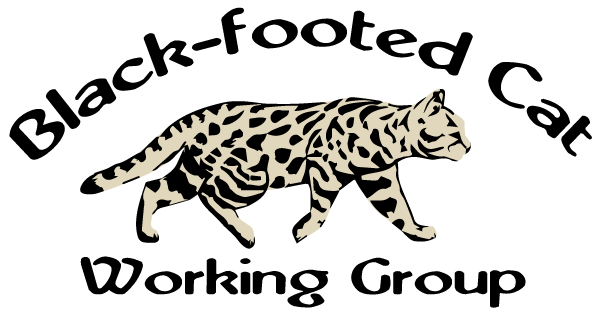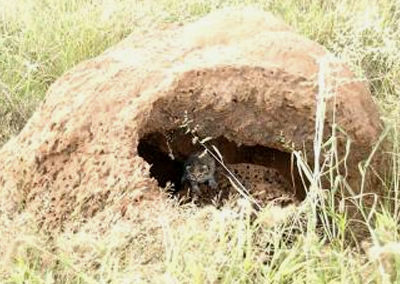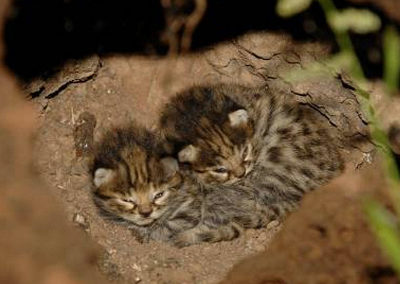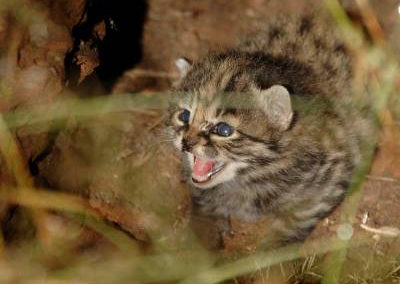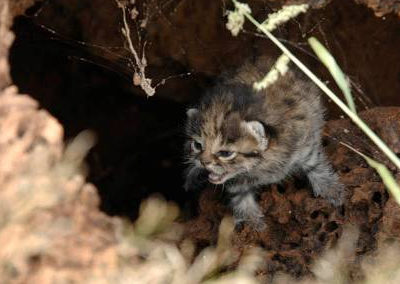Field Reports
Black-footed cat field research reports from southern AfricaBlack-footed cat field research techniques – photo gallery
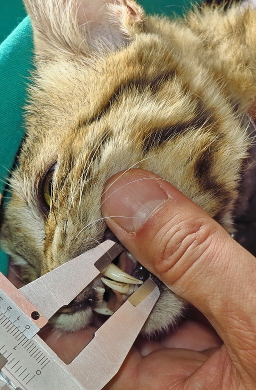
Each cat is measured, here the canines.
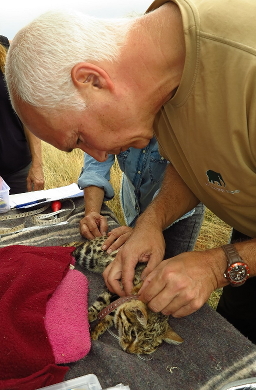
Dr. Sliwa fitting a female with a VHF radio-collar. Done more than 120 times.
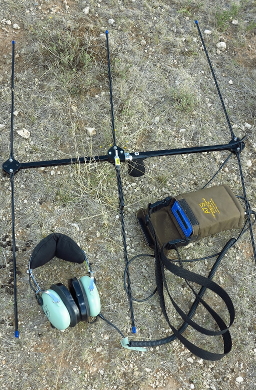
Antenna, receiver and headphones for tracking the collared cats.
We use high vantage points, like this windmill, for receiving a signal.
More commonly, we scan for signals from the top of the tracking vehicle.
In the Karoo we use koppies (kopjes) for tracking.
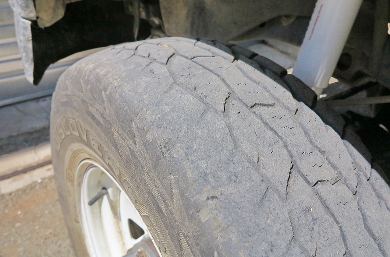
Tyres of the tracking vehicle wear down quickly.
Black-footed Cat field research
reports by year
2025
Swanepoel, M., 2025. Black-footed Cat Working Group Quarterly Report 1 May 2025.
Swanepoel, M., 2025. Black-footed Cat Working Group Quarterly Report 2 July 2025.
Swanepoel, M., 2025. Black-footed Cat Working Group Quarterly Report 3 September 2025.
2024
Swanepoel, M., 2024. Black-footed Cat Working Group Quarterly Report April 2024.
Swanepoel, M., 2024. Black-footed Cat Working Group Quarterly Report August 2024.
Swanepoel, M., 2024. Black-footed Cat Working Group Quarterly Report November 2024.
Swanepoel, M., 2024. Black-footed Cat Working Group Quarterly Report December 2024.
2023
Swanepoel, M., 2023. Black-footed Cat Working Group Quarterly Report April 2023.
Swanepoel, M., 2023. Black-footed Cat Working Group Quarterly Report June 2023.
Swanepoel, M., 2023. Black-footed Cat Working Group Quarterly Report September 2023.
Swanepoel, M., 2023. Black-footed Cat Working Group Quarterly Report December 2023.
Field research 2016
Field assistant Martina Küsters sent photos and wrote:
As part of my Master’s study “Home range size and density of vertebrae prey of black-footed cats on farmland”, bird counts and small mammal trapping were done in the home ranges of females in March and October to estimate prey density. Small mammal trapping entailed laying out 300 small box traps baited with peanut butter and rolled oats. Trap success was very low (0.24%) for the amount of effort (5,000 trap days). Rodents caught were Cape Short-tailed Gerbil Desmodillus auricularis, Hairy-footed Gerbil Gerbillurus paeba, Pygmy Mouse Mus minutoides, Pouched Mouse Saccostomus campestris; Southern Multimammate mouse Mastomys coucha and Round-eared Elephant Shrew Macroscelides proboscideus.
Field conditions on the farms are rough, where the climate is unpredictable and the off-road driving is challenging. The vehicle and equipment must tolerate intense use and hence constant maintenance and repair is required. The funds received by gracious supporters are crucial in order to keep doing the research and maintain the vehicle and equipment.
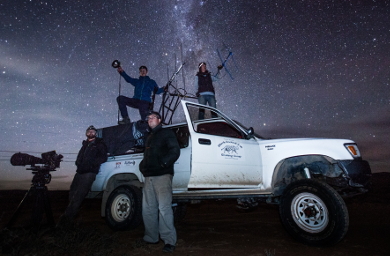
Film crew
In November, a BBC film crew was in De Aar for 10 nights to film sequences for the new series “Big Cats” to be screened in 2018. I was driving while observing the cat and got them in position in time to film stalking, ambushing and hunting behaviour. The camera man got off our research vehicle and filmed the female cats with a special low light camera. This was very successful with many great hunting and feeding moments captured. In addition, a camera was set up at the den of a female with kitten. For a short preview please visit http://www.bbc.co.uk/programmes/p05txr28
The BFCWG had their annual capture and collaring trip at the end of October 2016. It was very successful with all five collared cats re-collared and two new males (Hulk and Darth) caught in De Aar and two new males (Luke and Anakin) and one female (Leia) captured and collared on Benfontein. Despite the dry weather conditions and low rainfall throughout 2016, all three female Black-footed Cats in De Aar gave birth in October. After the great loss of Zuma in August, the births represent new life and hope for the next generations of Black-footed Cats in the Karoo.
Benfontein Black-footed Cats
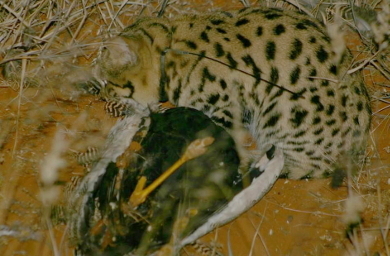
Bolt with Northern black korhaan
Bolt was amusing to watch as he actively scent marked any shrub, grass, termite mound or fence post. On one night as I followed him in dense grass, I heard a muffled ‘quak’ and I as I slowly approached, I could see Bolt feeding off something large. He had killed a male Northern black korhaan Afrotis afraoides. Although his home range partially overlaps with the female Freya, they were never seen interacting. Unfortunately, Bolt died in October 2016. His body was quite decomposed but there were bite marks on the collar, consistent with indentations made by black-backed jackal canines. There were also wounds on his face and lower back. He probably died of infection of these bite wounds. He was first captured in 2014 and I have been blessed with many, many interesting observations and happy memories while tracking him.
Gust, the younger male who roamed the south of the reserve died in April. I heard the mortality signal towards the farm to the south-west of Benfontein, Melrose-West farm. I have on several occasions been on that farm to look for Bolt in 2015 when he used to go there. The farmer, Mr Kobus van der Waldt has always been very helpful and it was no different when I phoned him to ask if I could go inspect what had happened to Gust. We found Gust’s skeletal remains on the plains close to the farm houses and windmill. It is quite unusual for a wild Black-footed Cat to come so close to human habitation and we suspect that he may have been sick. Unfortunately I cannot confirm cause of death as there are only skeletal remains. There are no bite marks on the collar or bones, as is usually the case with predation.
Odin now seems to be using the central and eastern parts of Benfontein more. He regularly went to the farm to the west in the first months after capture. The social dynamics on the reserve may be such that there is regular shifting of male home ranges as they compete for space and females. He has interesting marking behaviours and often urine-sprays squatting or marking into holes in the ground.
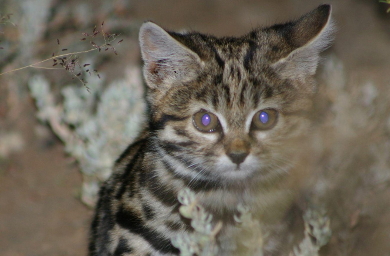
Freya’s kitten
Freya is resident in the area of the reserve where the vegetation is mostly dense, tall grass, making visual observations difficult. She has habituated well to the tracking and does allow me to get close. Freya was seen with an un-collared male in mid-August and by late October one could see that she was in the last term of pregnancy, as her belly extended both sides.
Unfortunately I was unable to locate Cinda in January 2016. This means that she may have moved off Benfontein, that the collar failed or she was killed and the transmitter or antenna of the collar damaged.
Mars occupied the northern lower lying part of the reserve, after disappearing in April 2016. He may have dispersed as stronger males expand their home ranges and displace him.
Thor was a very active cat, inspecting all den systems, termite mounds and often sits and watches the vehicle. I did not see him scent-mark, which indicates if a Black-footed Cat is resident. Sadly, he too could not be located by April 2016. I continued to search for him for months after that but his fate is not known.
De Aar Black-footed Cats
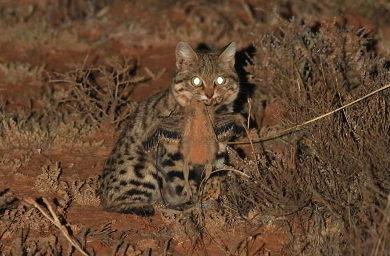
Gyra hunting a korhaan chick
A BBC film crew and I followed Gyra for 10 nights to document her amazing hunting behaviour. Before the filming started, Alex, Beryl, Paul Williams (the BBC producer) and I were following Gyra as she wandered around. We spotted a pair of blue korhaans Eupodotis caerulescens and instantly ‘Gyra’ went into hunting mode and circled the pair as they walked away. She was able to intersect one and quickly killed it. She didn’t immediately start feeding but was distracted by a high pitched scream near by. She went to inspect and then it became clear that the sound was coming from a korhaan chick that was hiding in the shrubs. She also killed the chick and ran off with it. This was an amazing sighting and shows that female Black-footed Cat can easily take down large prey, given the right circumstances. On a sad note, Gyra was observed drinking frequently from several water troughs throughout her area. It is suspected that she is affected by AA amyloidosis (“kidney disease”). She still looks in good condition, although she was a bit underweight at recapture but for now she is still fit and actively hunting. She gave birth to two kittens at the end of September. By November, only one had survived.
I could follow Luna easily with the tracking vehicle or on foot, as she used the neighbouring farms as well. She is an avid bird hunter and will ambush and stalk her prey patiently. Unfortunately I do not know the fate of her kitten seen in December 2015. Sadly, Luna was found dead in April on the neighbouring farm Haartebeesthoek (HBH). She had been on HBH for a few days and as on previous occasions, she would spend a few days and return to Nuwejaarsfontein. After hearing the mortality signal, I immediately contacted the neighbouring farmer to collect her carcass and assess what had happened. Mr Sakki van Zyl, owner of Stuurmanskuilen farm (neighbour farm of HBH and Nuwejaarsfontein) kindly agreed to take me (on a Sunday night!) to the area. Luna was found in a rocky area, huddled up in a hollow termite mound. Her carcass was fresh with no scavenging activity and some bite marks on her side and spinal column which appeared to be the cause of death. Project manager Beryl Wilson performed the necropsy to assess the cause of death and to collect tissue samples. The shape and size of the bite marks on the collar suggest she was attacked and bitten by a caracal. Mr. van Zyl confirmed that there was a Caracal in the area. The necropsy revealed that Luna was a strong, healthy cat in good condition. This unfortunate incident shows just how vulnerable these little predators are and that each cat is an important contributor to the population.
Nele is a resident female in the area and good data on home range size, feeding and behaviour was collected on her. She was heavily pregnant end of September. It is estimated that she gave birth on 29 September on the neighbouring farm Eselsfontein, because I saw her peeping from a hollow termite mound. A few days later, I confirmed that two tiny kittens where inside termite mound. She and her kitten were filmed by the BBC, with a camera set-up at the den.
Keeping track of Zuma was a mission; first to find the signal, then to locate him and see often leads to a mountain climbing and bush-whacking adventure. In June and July he had erratic movements, roaming over the neighbouring farms to the west and south. He was probably searching for receptive females or was chased out by competing males (e.g. the large un-collared male seen in the area). After he was lost for about a week, I found him again near a farm house on the neighbouring farm Eselsfontein, to the east of Nuwejaarsfontein. He was ill, had some facial wounds, had become very thin and only moved between the farm house and wind mill two kilometres to the east, presumably needing to drink regularly due to inflammation and fever. Then on 3 August, he died. The cause of death is assumed to be renal failure and chronic inflammation, due to AA amyloidosis. The kidneys were abnormal in colour, consistency and appearance, indicative of renal failure. The kidneys, liver and spleen were preserved and will be analysed to confirm amyloid proteins in the organs. This is a sad event for the project, having lost a male that has been collared for nearly three years. Mortality is important data to collect in order to determine causes of death, estimate life span and prevalence of disease (i.e. amyloidosis) of wild Black-footed Cats.
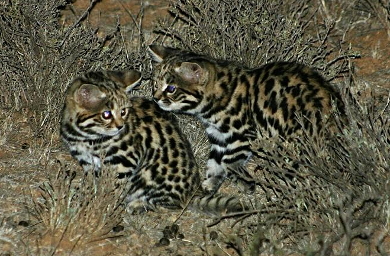
Sani and kitten
Sani is spending a lot more time on Taaiboschpoort farm, on which I can track her with the vehicle. I follow her and observe energetic hunting, relentless searching for food and the occasional rest and grooming session. I track her during the day to record her den sites and set up the camera trap. When I downloaded the pictures, I was very surprised to see that she had two kittens! She has been using a much smaller area on TbP for the past two months but I was never able to determine whether she had kittens. The kittens are estimated at 3-4 weeks old. She then moved the kittens the same night. The camera trap also recorded a Cape fox and a grey mongoose inspecting the den, both potential predators of the kittens. The two kittens were seen twice in October and the team also saw them in November, during our capture period. By mid November only one had survived. In December, the kitten was about 3.5-4 months old but I could not locate it again, although I follow Sani extensively to see whether she returns to it with food. But these cats are secretive and by that age the kitten could be hiding more. I did observe her mating in mid October with the large un-collared male.
Sadly, Epoc‘s chewed up body was found end of January near a water point on the neighbouring farm. The cause of death could not be determined due to the state of the carcass and time passed since death. Smaller scavengers probably fed on the carcass making cause of death difficult to establish.
Suggested citation:
Küsters, M. 2018. Monitoring Black-footed Cats in Benfontein Nature Reserve, Nuwejaarsfontein Farm and Taaiboschpoort Farm, South Africa. Black-footed Cat Working Group.
Field research 2015
Field Technician Martina Küsters sent photos and wrote:
The Black-footed Cat Working Group had their annual capture event end of November 2014. We caught four new Black-footed Cats, two females, Nele and Sani and one male Epoc on the farms and one male Bolt on Benfontein and replaced the collars of Zuma and Stan. We had high mortality of cats in 2014 (Faf, Ilse, Hasi and Kubu), and some dispersed or disappeared (Bama and Ego). Heavy rain before and during the capture complicated field work and limited the time to capture effectively.
A record total of 12 Black-footed Cats were collared at the end of 2015. Eight new cats were caught, and we replaced the collars of Nele, Sani, Zuma on the farms and Bolt on Benfontein Nature Reserve. On the farms, two females Luna and Gyra were caught in the northern areas of Nuwejaarsfontein Farm. On Benfontein, six new cats were fitted with radio collars; the males Mars, Thor, Gust and Odin and the females Freya and Cinda. Most of the females were pregnant, had kittens or gave birth within the coming two weeks.
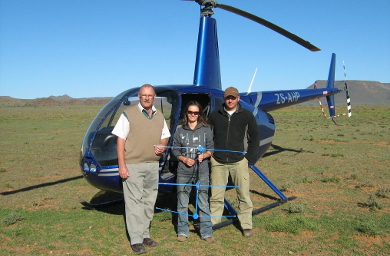
Sterrie Marais (owner of Nuwejaarsfonetin Farm) and helicopter
In order to locate the females more easily and to spend less time walking long distances, the co-operation and support of neighbouring farmers is needed. This is what conservation on farmland is about, creating awareness and involving the farmers in the research. Most of the neighbouring farmers are very helpful and allow me access to their farms with a vehicle. In an attempt to find a missing male Black-footed Cat, Sterrie Marais (owner of Nuwejaarsfonetin Farm) kindly arranged for me to fly with the helicopter and listen for signals from the air.
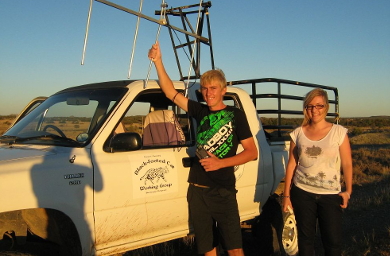
Dana Joubert and Michelle Rodgers
Dana Joubert, a farmer from Aranos in Namibia who is a ‘custodian’ for Black-footed Cats on the farms in eastern Namibia and who has been involved with the study of Black-footed Cat distribution in Namibia and a nature conservation student, Michelle Rodgers from the PolyTechnic of Namibia, visited the project to help with field work and have the opportunity to see free-ranging cats.
As part of my Master’s study on habitat and home range use by Black-footed Cats on farmland, vegetation surveys were done to collect data on shrub and grass cover, species composition and density. I am very grateful to Dr. Lorraine van den Berg from the Department of Pasture Research at the Grootfontein Agricultural College, near Middleburg, for her help to identify plants.
A road-killed black-footed cat was reported on the R48 tar road between De Aar and Philipstown by Prof. Reilly from the Tswane University of Technology, my supervisor for my Master’s. The remains were deposited with the mammal collection at the McGregor Museum in Kimberley. The remains of all collared Black-footed Cats that die during the study are stored at the Museum for later analysis.
During mating time at the end of July and into August, un-collared females or male cats are often seen with the collared animals.
Benfontein Black-footed Cats
Bolt had settled in the south-eastern section of the reserve. In 2014, I could expect to find him anywhere on Benfontein but the population dynamics have changed and many more cats now share the same area. He actively marks any shrub, termite mound and even wooden poles once used as fencing posts. He is well habituated, allows close observations and photography and a perfect cat to show visitors.
Mars was still a fairly young male when he was caught and probably still roamed within his mother’s home range in the northern lower lying part of Benfontein.
Cinda, a beautiful female, got her name from ‘Cinderella’, because we caught her just after midnight. She is in very good condition and is expected to give birth towards the end of November.
Gust was named after gusty and cold winds we experienced during the capture and processing in the field. His bodyweight and teeth condition indicates that he is still a young adult male.
We spotted Odin at midnight and after a short run he went into a massive den. After extensive and careful digging, the den opened up into a larger canal and chamber. Martina, the smallest person crept into the hole to entice him to run out into the net at the entrance. First he did not budge but after some time he slowly crept past me and ran into the net. He is a healthy adult male and we suspect he is one of the resident males on Benfontein. His muscular physique and self-assured manners prompted us to his name.
Thor was caught after some running by the catchers with nets in the eastern section of Benfontein. We named him sticking to our beginning practice of naming cats after Nordic gods.
Freya, an adult female, was named after Odin’s wife, as she was heavily pregnant, expected to give birth mid November. Her markings are very beautiful and bold and she is in excellent condition.
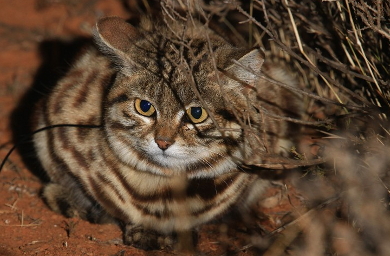
Nele
Nele habituated well to the vehicle and tracking on foot, as well as camera traps set up at her day-time resting dens. In December 2014 I saw her mating with a large un-collared male. He closely followed her for two days. Dana and I were fortunate to observe Nele feeding on a blue korhaan Eupodotis caerulescens. She hectically plucked the feathers and fed quickly, always very wary of who might come steal her prey. In August, she was observed marking with urine sprays, rolling and scratching.
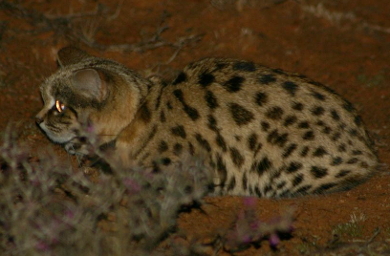
Sani
Sani, the adult female roams large parts of the neighbouring farm Eselsfontein, and thus it was important that we have access but also good relations with the neighbouring farmer. She often hunts in rocky slopes, where she patiently ambushes birds resting between shrubs. I could follow and observe her well on foot. As on one night I tracked her but could not see her characteristic red eye shine and only saw her when I heard the flutter of wings. She caught a bird about 5m from me, looked at me and ran 30m to feed. In August she was regularly urine-spraying. I found her and Zuma resting together one night. He followed her for two nights and although mating was not observed, they probably did mate.
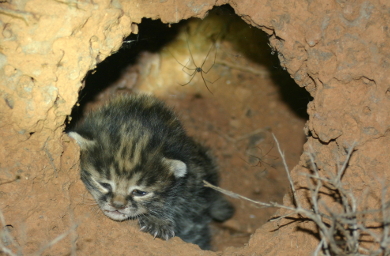
Luna’s kitten
Luna was captured on a night with the bright moon shining above. A week after capture, one kitten was discovered in a termite mound. She also roams into the neighbouring farms to the east.
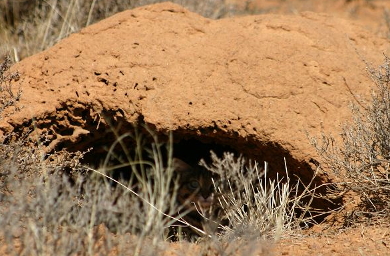
Gyra guarding kittens
Gyra was caught on yet another adjoining farm – Klein Rooidam. She circled extensively and thus got her name from ‘gyrocopter’. At the end of November, Gyra’s two kittens aged approximately 6 weeks old were seen. Gyra is an energetic and relentless hunter of birds and will often patiently ambush and stalk any roosting bird.
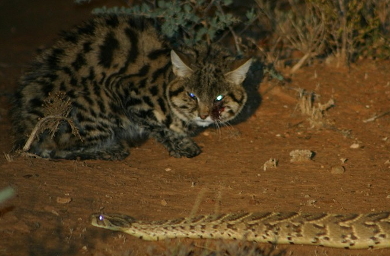
Stan with puffadder
Stan had lost considerable condition throughout the year and had moved further north. Fortunately I know the landowner and was able to monitor him there. He was resting near a water trough and had a large abscess on his face. At night he did not move far from the water and did not really hunt. Although he was sick this did not deter him from agitating a big puff adder! He went up to the snake, slapped it on the head, and the snake retreated into a bush. First I thought he got bitten, but he then just watched, groomed, and the snake moved off. Sadly the next day he was dead. In order to determine cause of death, he was driven the next day to Kimberley, and Beryl Wilson drove him to Pretoria for an autopsy by Dr. Emily Lane (Pathologist at Onderstepoort Veterinary Institute) and Dr. Adrian Tordiffe (BFCWG’s veterinarian). This was an opportunity to examine a wild, free-ranging Black-footed Cat that had died of natural causes and maybe show amyloidosis, a disease that causes kidney failure. The autopsy confirmed that death was caused by renal failure due to amyloidosis, severe weight loss and infectious disease. These findings are important to show that amyloidosis not only affects captive but also wild Black-footed Cats.
Zuma looks in good physical condition and has grown into a beautiful big, confident adult male. His home range is large (about 51.8 km²) and has increased from 2014. He now overlaps with the home ranges of the two resident females Nele and Sani, spending more time to the south, on Eselsfontein and Taaiboschpoort. The large un-collared male with Nele in December 2014 may have contributed to Zuma shifting his home range further south.
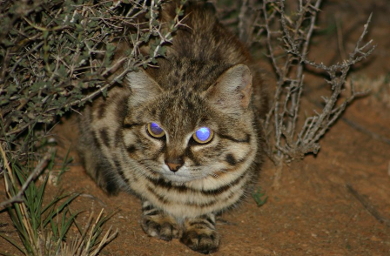
Epoc
Epoc, a young adult male caught on Taaiboschpoort could be easily tracked and had habituated well. I could observe him closely, even while feeding. He was observed feeding on a yellow mongoose. At the end of November I saw an encounter between Sani and Epoc which involved a lot of watching, chasing and a short scuffle, before they parted ways.
Suggested citation:
Küsters, M. 2018. Monitoring Black-footed Cats in Benfontein Nature Reserve, Nuwejaarsfontein Farm and Taaiboschpoort Farm, South Africa.
Field research 2014
During 2014, field assistant Martina Küsters monitored and observed radio-collared Black-footed Cats in Benfontein Nature Reserve near Kimberley and two farms south-west of De Aar, in South Africa.
In September Martina sent photos and wrote:
Benfontein Nature Reserve
In the beginning of August, Benfontein Nature Reserve and the farms close to De Aar received some rain. The weather was mostly cold and windy. It turned very cold at the end of August when a cold front moved in from the Cape, and minus temperatures and snow where recorded in the central Karoo. But it is the start of spring, some bushes are flowering, and the rain and sunnier days have sparked mating behaviour. I regularly saw pairs of porcupine, aardwolf and even aardvark. Now is the typical winter mating time for Black-footed Cats.
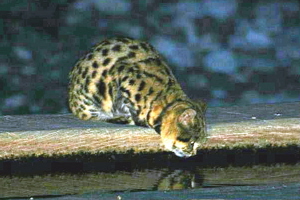
Kubu drinking at a water trough
Kubu was only in the southern part of his home range during the monitoring period. He seems to regularly drink water, as he was again observed drinking at ‘Nine Tanks’, one of the artificial water troughs in his area. He sat on the trough and rested, occasionally drinking. When leaving he scent-marked the trough. He was observed feeding on a Cape clapper lark and gerbil.
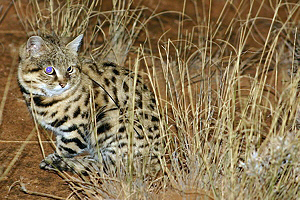
Kubu listening for prey
Two nature enthusiasts came out to the project and were able to observe Kubu foraging and resting close-up.
Unfortunately, Bama, the roaming male on the neighbouring farms, Suzanna and Rooifontein, has not been located since February this year. He has probably wandered off and found a suitable territory. Or maybe he has been killed and his collar stopped transmitting.
De Aar
Black-footed Cats have been caught near Nuwejaarsfontein and Taaiboschpoort Farms since 2009. These two sites may highlight the importance of studying wild populations in a different habitat and with a different land use pattern than the protected area of Benfontein. The work in these areas is important to understand home range size, habitat use and population density. Also, these sites will be used to estimate seasonal prey density and availability in the near future.
Nuwejaarsfontein Farm (NJF)
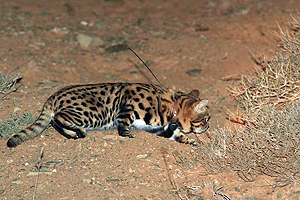
Zuma stalking
Zuma actively marks the area during his nightly forays, and often sprays the larger bushes. On 16 August, he was seen with an un-collared female cat in the area formerly used by Ilse, the old female that died in May 2014. Although I could not see actual mating, there were signs of courtship. The female was shy and did not allow closer observations. Zuma has since been using the area more intensively.
He often enters den systems made by springhare or other fossorial animals, presumably to hunt. On three consecutive nights I found him at the same dens, and then set-up the project’s camera traps to monitor movement at the entrance. He returned twice during a 24-hour period, sniffed at the entrance, inspected the camera traps and probably scent-marked one of the cameras, as there was a strong smelling substance on the outside of the camera. On the camera with the video and sound function, there is a short clip of a cat moving away and vocalising (‘meaowing’). This could have been Zuma or another cat, as only the hindquarters can be seen.
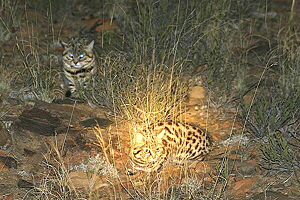
Stan with female
Stan still spends more time on the neighbouring Bosjesmansfontein Farm to the north than on NJF. Fortunately I have access to this farm with the tracking vehicle and am able to monitor him. I have finally seen him scent-marking, suggesting that he is resident. His regular and often predictable movements make it easier to find him in his large home range. He recently spent one night quite a long distance out of his normal range, about 4 km to the north-west, but returned the next night. On several occasions, I have seen a cat without a collar, and suspect that there was a female in his range. When Stan was located on 30 August, a female was with him. He closely followed her every move, and when she came close to inspect the tracking vehicle, he followed her. That’s when I was able to photograph the female and Stan. She refused his advances and soon they parted ways as I did not see her again.
In the beginning of August, I found Hasi‘s collar and some hair in the area on NJF 20 km farther north, which she had used since June. Jackals were recently seen there, which is why I suspect that they may have killed and consumed her.
Taaiboschpoort Farm (TbP)
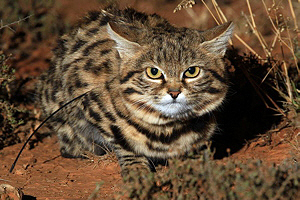
Ego
Unfortunately, I was not able to locate Ego despite searching the extent of his known home range for many nights, climbing high mountains on TbP and the neighbouring Mynfontein Farm to the west. He may have permanently dispersed out of the area.
There may be options for an aerial search with a helicopter or para-glider, depending on availability and weather conditions. I hope that he will soon be found!
In June, Martina sent photos and wrote:
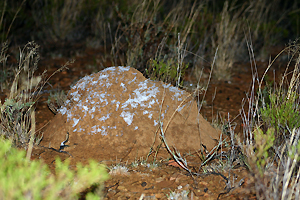
Icy termite mound
Temperatures in June ranged between a maximum of 18℃ during the day and -2℃ in the early morning hours. Although temperatures were mostly mild, on a few nights the Karoo winter could already be felt. One night I had rain and sleet covered the shrub lands, and termite mounds glistened in the moonlight. I have exciting and special news this month. I hope you enjoy it, as this highlights the importance of doing long-term research on a lesser studied, nocturnal carnivore, like the Black-footed Cat.
Benfontein Nature Reserve
The reserve is owned by De Beers Consolidated Mines and situated 10 km southeast of Kimberley. It has been the focus of Black-footed Cat research since the 1990s, and much of what is known about wild Black-footed Cat has been done by Dr. Sliwa on Benfontein. This reserve serves as an important long-term monitoring site for research and conservation of Black-footed Cats. I tracked the Black-footed Cats on Benfontein from 5 to 8 June.
Unfortunately Bama, the roaming male that was last located in February 2014 on the neighbouring farms, Suzanna and Rooifontein, has not been located again. He has probably wandered off and found a suitable territory, as the dominant male Kubu would not tolerate his presence on Benfontein. However, since signals of his radio-collar have not been received since four months, he could also have died.
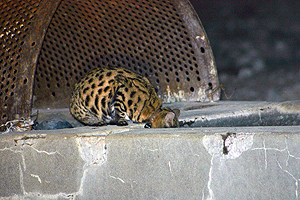
Kubu drinking at water trough
Like Stan, Kubu has a wound on the left side of his nose. How or when he got the wound is not known but it seems the wound is healing. The veterinarians of the BFCWG have suggested that the lesions represent sub-acute to chronic inflammation. This could have been caused by territorial or inter-specific fighting or injury during hunting. During the three monitoring nights he was only in the south-western part of his home range between two waterholes. I followed him to the one windmill where he searched for prey in the bushes. He then went to the waterhole, jumped on the concrete trough and drank. Kubu was seen drinking water on two separate nights and twice in one night. Frequent drinking in Black-footed Cats is an indication that their kidneys might be affected by a disease called amyloidosis, most prevalent in captive Black-footed Cats, but also recorded in wild ones. However, he was observed catching and eating a Cape clapper lark Mirafra apiata and an ant-eating chat Myrmecocichla formicivora. We hope that he is in good health and that he drinks water simply because it is available. The BFCWG has collected 167 GPS waypoints since November 2013. He actively marks and uses most of Benfontein and preliminary results indicate that his home range is as large as 48 km2.
De Aar
There are two study sites located south of De Aar, Nuwejaarsfontein Farm (NJF) and Taaiboschpoort (TbP) Farm. Black-footed Cats have been caught here since 2009, and these sites may highlight the importance of studying wild Black-footed Cat populations in different habitats and with different management systems.
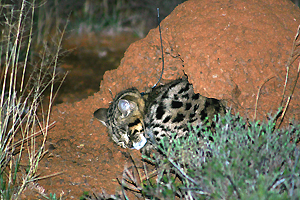
Zuma resting in a termite mound
Zuma actively marks the area, indicating that he is a resident male, yet it does not reflect his dominance status. He also wanders far into the neighbouring farm, but always returns to his core area. He often intensively inspects springhare den systems for prey. Zuma also likes to use hollow termite mounds to rest, often I only see him peeping out when approaching.
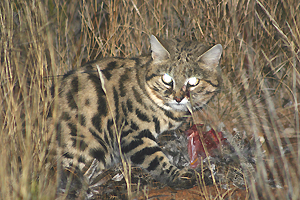
Stan with grey-winged francolin
Stan spends more time on the neighbouring farm (Bosjesmansfontein farm) than on NJF. As I have access to Bosjesmansfontein farm with the tracking vehicle I am able to monitor him. He is quite habituated and allows close observations. He likes to forage on hill slopes in very rocky terrain with dense vegetation cover. It may be that he hunts Smith’s red rock hares Pronolagus rupestris, a species that lives on rocky slopes and outcrops. I was lucky enough to observe him successfully hunting a grey-winged francolin Scleroptila africanus, a new species of bird on the Black-footed Cat’s prey list.
Taaiboschpoort Farm (TbP)
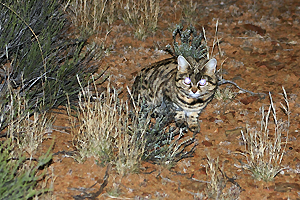
Hasi
After loosing Hasi‘s signal end of May, I searched the extent of her home range. Since a photo indicated that the antenna of the collar may have broken off, I had little hope to find her. I saw jackal in the area and was certain that they killed her and chewed the collar, so we went searching the area on foot, without luck finding any sign of her or the collar.
But then, two nights later as I was listening for Stan’s signal, I heard her signal instead!! All the way up north where Stan hangs out and more than 19 km (measured straight line) from where I had last seen her! I quickly walked after her and could approach and follow her very close, up to 3 m and could see the antenna and collar very well. The antenna is still attached, although the plastic sleeve attaching the antenna to the collar has broken off and is now hanging on the end of the antenna. She caught a lark just meters from me and proudly walked off to feed 30 m away. The range of the signal is good, as normal. This is amazing; what would make her walk 19 km north when there is suitable habitat in between? It may be that the available habitat is occupied, an indication that there is a healthy population of Black-footed Cats, especially females on NJF and TbP. I really hope the antenna does not break off and that she establishes a new home range in that area. It seems the habitat is good, with adequate numbers of larks and rodents. In the new area, I have seen her catching 3 larks.
Ego spent a lot of time on the neighbouring Mynfontein Farm to the west. The boundary fence was repaired and the bottom electric strand redone. This may have prevented him from returning back onto TbP or another male has claimed his home range. Unfortunately, I have been unable to locate his signal during the last nights of tracking. I have visited Mynfontein farm twice, climbed high mountains to listen for his signal but without luck. The owner of Mynfontein farm will keep an eye out for him. We hope that he soon returns to TbP.
Suggested citation:
Küsters, M. 2014. Monitoring Black-footed Cats in Benfontein Nature Reserve, Nuwejaarsfontein Farm and Taaiboschpoort Farm, South Africa. Black-footed Cat Working Group.
Field research 2011
During March to June 2011, field assistant Jonatan Borling monitored three radio-collared females. The coloured dots on the map below indicate their localisations during that time.
He collected new interesting data about kitten raising during times of strong rainfall.
Females use more hollow termite mounds during heavy rainfall.
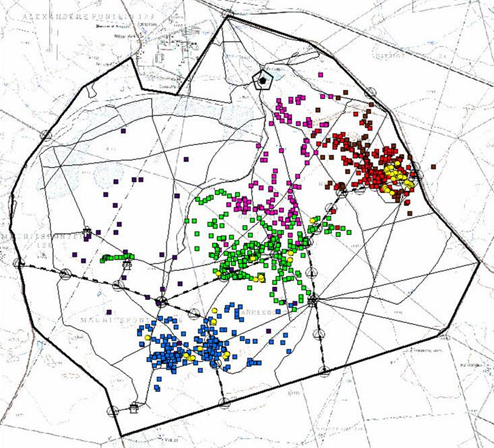
Cat positions in Benfontein 2011
Field research 1993–1998
What is known today about home range, behaviour and diet of the Black-footed Cat, was found out during a 6-year long field study in South Africa. The study area was located near the famous diamond city Kimberley in the Northern Cape Province.
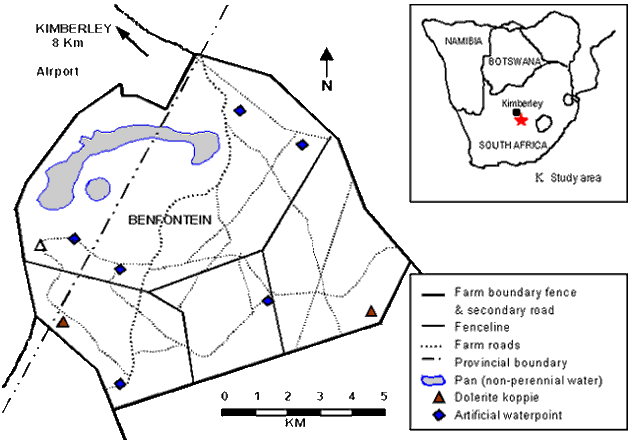
Black-footed cat study area in Benfontein, South Africa
-
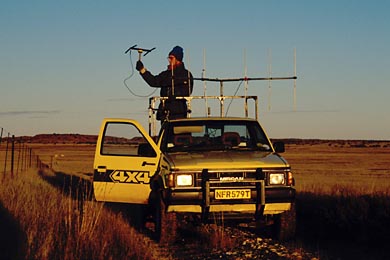
Dr. Alexander Sliwa tracking. Photo courtesy of Arne Lawrenz.
-
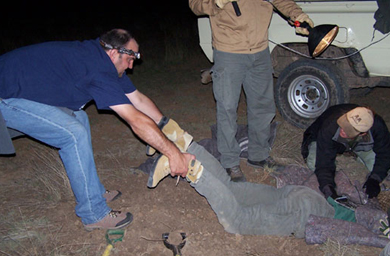
Catching cats: researcher is pulled out together with a cat from its den. Photo courtesy of Beryl Wilson.
-
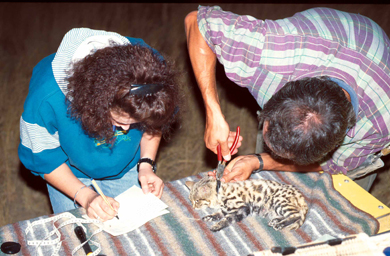
After being measured, this adult Black-footed Cat is fitted with a radio-collar. Photo courtesy of Rob Davies.
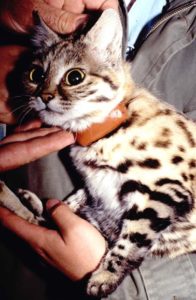 In February 1993, the zoologist Dr. Alexander Sliwa caught a female free-ranging Black-footed Cat with a self-made trap, and fitted her with a radio-collar for the first time. This radio-collar weighed only 50 g and sent signals for six months. Until 1998, he studied 21 different individuals in their natural habitat.
In February 1993, the zoologist Dr. Alexander Sliwa caught a female free-ranging Black-footed Cat with a self-made trap, and fitted her with a radio-collar for the first time. This radio-collar weighed only 50 g and sent signals for six months. Until 1998, he studied 21 different individuals in their natural habitat.
Patiently, he habituated the cats to the presence of a four-wheel vehicle, tracked them cross-country over 2,000 km and mostly at night for more than 3,000 hours. During this time, he was able to directly observe the cats for more than 1,600 hours while hunting, mating and raising their young.
